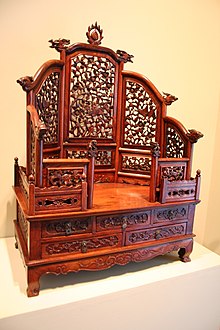fi
nimet breadcrumb-navigoinnissa


Dalbergia odorifera,[2] (chinu: 降香黄檀, pinyin: jiàngxiāng huángtán, lliteralmente «drooping fragrant dalbergia»), ye una especie de llegume na familia Fabaceae.
Trátase d'un árbol de tamañu pequeñu o medianu, qu'algama los 10-15 metros d'altu.[3] Ye endémicu de China y produzse en Fujian, Hainan, Zhejiang,[3] y Guangdong.[4]
Utilízase como un productu pola so madera y na medicina tradicional.[2] Esta madera pervalible ye conocida en China como huali mariella. La mayoría de los muebles de mayor calidá del Ming y principios de la dinastía Qing yeren de Huali, agora conocida como Huanghuali, pa estremala de la madera popular moderna llamada xinhuali[4]
Cuatro compuestos aisllaos del raigañu d'esta planta demostraron nun llaboratoriu que pueden tener propiedaes antiosidantes.[5]
Ta amenazáu pola sobresplotación.[1]
Dalbergia odorifera describióse por Tê Chao Chen y espublizóse en Acta Phytotaxonomica Sinica 8(4): 351–352. 1963.[6]
 Esta páxina forma parte del wikiproyeutu Botánica, un esfuerciu collaborativu col fin d'ameyorar y organizar tolos conteníos rellacionaos con esti tema. Visita la páxina d'alderique del proyeutu pa collaborar y facer entrugues o suxerencies.
Esta páxina forma parte del wikiproyeutu Botánica, un esfuerciu collaborativu col fin d'ameyorar y organizar tolos conteníos rellacionaos con esti tema. Visita la páxina d'alderique del proyeutu pa collaborar y facer entrugues o suxerencies. Dalbergia odorifera, (chinu: 降香黄檀, pinyin: jiàngxiāng huángtán, lliteralmente «drooping fragrant dalbergia»), ye una especie de llegume na familia Fabaceae.
Dalbergia odorifera (lat. Dalbergia odorifera) - paxlakimilər fəsiləsinin dalbergiya cinsinə aid bitki növü.
Dalbergia odorifera (lat. Dalbergia odorifera) - paxlakimilər fəsiləsinin dalbergiya cinsinə aid bitki növü.
Dalbergia odorifera, fragrant rosewood or Chinese rosewood[3] (Chinese: 降香黄檀; pinyin: jiàngxiāng huángtán; lit. 'drooping fragrant dalbergia'), is a species of legume in the family Fabaceae. It is a small or medium-sized tree, 10–15 metres (33–49 ft) tall.[4] It is endemic to China and occurs in Fujian, Hainan, Zhejiang,[4] and Guangdong.[5]
It is used as a wood product and in folk medicine.[3] This valuable wood is known in China as huali (花梨) or huanghuali (黄花梨).[5] Furniture from the late Ming and early Qing dynasties was made of this wood[5] and new furniture in the same styles are sought after as luxury and prestige items.[6]
Four compounds isolated from the root of this plant have been shown in a laboratory to have antioxidant properties.[7]
A deciduous tree, D. odorifera will start shedding leaves at around December of each year in the Northern Hemisphere. It becomes dormant throughout the winter months.
It was overexploited in the twentieth century and was classed as a vulnerable species in 1998.[1] This reached a level in the early twenty-first century where most trees of a size for commercial use had been cut down. As a consequence, other species of Dalbergia started to be exploited in its place.[6]
Dalbergia odorifera, fragrant rosewood or Chinese rosewood (Chinese: 降香黄檀; pinyin: jiàngxiāng huángtán; lit. 'drooping fragrant dalbergia'), is a species of legume in the family Fabaceae. It is a small or medium-sized tree, 10–15 metres (33–49 ft) tall. It is endemic to China and occurs in Fujian, Hainan, Zhejiang, and Guangdong.
 Chinese dressing cabinet made from Huanghuali wood, Qing Dynasty (17th-18th century)
Chinese dressing cabinet made from Huanghuali wood, Qing Dynasty (17th-18th century) It is used as a wood product and in folk medicine. This valuable wood is known in China as huali (花梨) or huanghuali (黄花梨). Furniture from the late Ming and early Qing dynasties was made of this wood and new furniture in the same styles are sought after as luxury and prestige items.
Four compounds isolated from the root of this plant have been shown in a laboratory to have antioxidant properties.
A deciduous tree, D. odorifera will start shedding leaves at around December of each year in the Northern Hemisphere. It becomes dormant throughout the winter months.
It was overexploited in the twentieth century and was classed as a vulnerable species in 1998. This reached a level in the early twenty-first century where most trees of a size for commercial use had been cut down. As a consequence, other species of Dalbergia started to be exploited in its place.
Dalbergia odorifera,[2] (en chino, 降香黄檀; pinyin, jiàngxiāng huángtán; literalmente, ‘drooping fragrant dalbergia’), es una especie de legumbre en la familia Fabaceae.
Se trata de un árbol de tamaño pequeño o mediano, que alcanza los 10-15 metros de alto.[3] Es endémica de China y se produce en Fujian, Hainan, Zhejiang,[3] y Guangdong.[4]
Se utiliza como un producto por su madera y en la medicina tradicional.[2] Esta madera valiosa es conocida en China como huali amarilla. La mayoría de los muebles de mayor calidad del Ming y principios de la dinastía Qing eran de Huali, ahora conocida como Huanghuali, para distinguirla de la madera popular moderna llamada xinhuali[4]
Cuatro compuestos aislados de la raíz de esta planta han demostrado en un laboratorio que pueden tener propiedades antioxidantes.[5]
Está amenazado por la sobreexplotación.[1]
Dalbergia odorifera fue descrita por Tê Chao Chen y publicado en Acta Phytotaxonomica Sinica 8(4): 351–352. 1963.[6]
Dalbergia odorifera, (en chino, 降香黄檀; pinyin, jiàngxiāng huángtán; literalmente, ‘drooping fragrant dalbergia’), es una especie de legumbre en la familia Fabaceae.
Dalbergia odorifera (jiangxiang huangtan en chinois) est une légumineuse (famille Fabaceae), du genre Dalbergia. Jusqu'en 1980, elle est connue sous le nom de Dalbergia hainanensis. Elle provient de la province chinoise de Guangdong et des terres du sud comme l'ile Hainan[2].
Ce bois précieux est connu en chine sous l'appellation de Huali. La plupart des mobiliers de grande qualité de la dynastie Ming et des premiers Qing étaient faits dans ce bois, appelé Huanghuali afin de le distinguer du bois moderne appelé xinhuali[2].
Dalbergia odorifera (jiangxiang huangtan en chinois) est une légumineuse (famille Fabaceae), du genre Dalbergia. Jusqu'en 1980, elle est connue sous le nom de Dalbergia hainanensis. Elle provient de la province chinoise de Guangdong et des terres du sud comme l'ile Hainan.
Ce bois précieux est connu en chine sous l'appellation de Huali. La plupart des mobiliers de grande qualité de la dynastie Ming et des premiers Qing étaient faits dans ce bois, appelé Huanghuali afin de le distinguer du bois moderne appelé xinhuali.
Dalbergia odorifera é uma espécie vegetal da família Fabaceae.
Apenas pode ser encontrada no seguinte país: China.
Está ameaçada por perda de habitat.
Dalbergia odorifera é uma espécie vegetal da família Fabaceae.
Apenas pode ser encontrada no seguinte país: China.
Está ameaçada por perda de habitat.
Dalbergia odorifera: tiếng Việt là Gỗ sưa hay Huỳnh đàn, còn tiếng Trung Quốc quen gọi là giáng hương Hoàng Đàn hay Hoàng hoa lê (huanghuali). Đây là một loài họ Đậu (Fabaceae). Là loại gỗ nổi tiếng đắt giá vì được vua chúa Nhà Minh và Nhà Thanh rất thích sử dụng làm đồ nội thất cung đình. Màu sắc đỏ, tím, vàng tùy vùng sinh trưởng, nhưng có chung đặc điểm ra gỗ rất thơm và màu đẹp bóng nên rất quý.
Tên tiếng Anh của nó là "fragrant rosewood".[2]
Loài này được dùng lấy gỗ hoặc làm thuốc cổ truyền.[2] Bốn hợp chất tách từ rễ cây của nó trong phòng thí nghiệm cho thấy chúng có tính chất chống oxi hóa.[3]
Loài này chỉ có ở Hải Nam, Trung Quốc và Bắc Bộ Việt Nam (sưa đỏ). Chúng hiện đang bị đe dọa và nằm trong sách đỏ Việt Nam. Tuy nhiên, ngày nay, cây sưa giống đang được trồng rộng rãi trong cả nước Việt Nam và trên phố Hà Nội vẫn còn có những cụ sưa già ra hoa, kết trái vào mỗi mùa Phật đản tháng Tư. Hoa sưa màu trắng đẹp nhẹ nhàng, tinh khiết và gỗ thì quý và 'đẹp như sắc gỗ sưa' mà văn học dân gian đã ca tụng.
Dalbergia odorifera: tiếng Việt là Gỗ sưa hay Huỳnh đàn, còn tiếng Trung Quốc quen gọi là giáng hương Hoàng Đàn hay Hoàng hoa lê (huanghuali). Đây là một loài họ Đậu (Fabaceae). Là loại gỗ nổi tiếng đắt giá vì được vua chúa Nhà Minh và Nhà Thanh rất thích sử dụng làm đồ nội thất cung đình. Màu sắc đỏ, tím, vàng tùy vùng sinh trưởng, nhưng có chung đặc điểm ra gỗ rất thơm và màu đẹp bóng nên rất quý.
Tên tiếng Anh của nó là "fragrant rosewood".
Loài này được dùng lấy gỗ hoặc làm thuốc cổ truyền. Bốn hợp chất tách từ rễ cây của nó trong phòng thí nghiệm cho thấy chúng có tính chất chống oxi hóa.
Loài này chỉ có ở Hải Nam, Trung Quốc và Bắc Bộ Việt Nam (sưa đỏ). Chúng hiện đang bị đe dọa và nằm trong sách đỏ Việt Nam. Tuy nhiên, ngày nay, cây sưa giống đang được trồng rộng rãi trong cả nước Việt Nam và trên phố Hà Nội vẫn còn có những cụ sưa già ra hoa, kết trái vào mỗi mùa Phật đản tháng Tư. Hoa sưa màu trắng đẹp nhẹ nhàng, tinh khiết và gỗ thì quý và 'đẹp như sắc gỗ sưa' mà văn học dân gian đã ca tụng.
降香黄檀(学名:Dalbergia odorifera)又稱海南黃花梨,是产于中国海南省的一种豆科蝶形花亚科的常绿乔木。其木材被称为“黄花梨”、“黄花黎”,其木材成材缓慢,木质坚硬,纹理漂亮,是制作古典红木家具的上乘材料。
海南黄花梨木的原产地是海南岛海拔600米以下的地區,除了東部山區外,島內各地均有零星分佈,其中以西部較集中。黄花梨是明式家具的主要用材。明朝后期明式家具兴起于长江下游的江南一代,并在清朝前期成为高档家具的主流,但由於过度砍伐,在乾隆年間資源基本枯竭,民間多用其製作筆筒等小件器物,很少出現大件黃花梨家具[2]。
黄檀木心被中医药称为降香,《本草纲目》中说“今折伤金疮家多用其节,云可代没药、血竭”,可以“疗折伤金疮,止血定痛,消肿生肌”。
降香黄檀(学名:Dalbergia odorifera)又稱海南黃花梨,是产于中国海南省的一种豆科蝶形花亚科的常绿乔木。其木材被称为“黄花梨”、“黄花黎”,其木材成材缓慢,木质坚硬,纹理漂亮,是制作古典红木家具的上乘材料。